History of Tsukuba Magnet Laboratory
- 1956 Establishment of National Research Institute for Metals
- 1960s Development of superconducting materials
- 1976 17.5T Superconducting Magnet
- 1986 18.1T Superconducting Magnet
- Discovery of Bi-based oxide superconductor
- 1988 Construction of hybrid magnet started
- 1993 21.1T Superconducting Magnet
- 73.4T Pulse Magnet
- Establishment of Tsukuba Magnet Laboratory
- 1995 36.5T hybrid magnet
- 1998 TML becomes an open facility
- 1999 37.3 Hybrid Magnet
- 23.4T superconducting magnet
- 2001 Establishment of National Institute for Materials Science
- 920 MHz (21.6T) high-resolution NMR magnet
- 2002 Completion of NMR Laboratory I
- 2003 Completion of NMR Laboratory II
- 2004 930MHz NMR Magnet
- 2005 Power supply modification
- 2008 Cooling system improvement for hybrid magnet
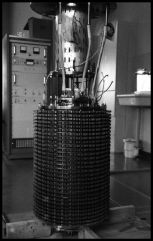 17.5T superconducting magnet which brought TML the first world's record of the magnetic field strength was developed. It consisted of an outer Nb3Sn solenoid with a 160 mm bore producing 13.5 T, and an inner V3Ga solenoid with a 32 mm bore producing an incremental 4T. This system was a successful result of the fruitful collaborative efforts with a large number of researchers and engineers from Intermagnetics General Corporation (Guilderland, NY), Vacuum Metallurgical Co. Ltd. (Tokyo, Japan) and NRIM. After the installation at NRIM, it has contributed many research programmes including high field superconductors.
17.5T superconducting magnet which brought TML the first world's record of the magnetic field strength was developed. It consisted of an outer Nb3Sn solenoid with a 160 mm bore producing 13.5 T, and an inner V3Ga solenoid with a 32 mm bore producing an incremental 4T. This system was a successful result of the fruitful collaborative efforts with a large number of researchers and engineers from Intermagnetics General Corporation (Guilderland, NY), Vacuum Metallurgical Co. Ltd. (Tokyo, Japan) and NRIM. After the installation at NRIM, it has contributed many research programmes including high field superconductors.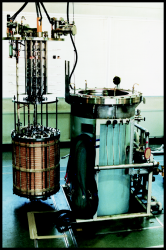 The new super conducting magnet has developed by combining (Nb,Ti)3Sn, NbTi and V3Ga wires. It has broken the own magnetic field record by generating 18.1 T in a 32 mm bore.
The new super conducting magnet has developed by combining (Nb,Ti)3Sn, NbTi and V3Ga wires. It has broken the own magnetic field record by generating 18.1 T in a 32 mm bore.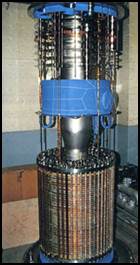 21.1 T was obtained by the new superconducting magnet with a larger clear bore, 50 mm. The innermost wind and react coil was wound around with a new superconductor, developed (Nb, Ti, Ta)3Sn. Saturated superfluid helium was applied as a coolant for this magnet, which was the first successful coolant application for large superconducting magnet system.
21.1 T was obtained by the new superconducting magnet with a larger clear bore, 50 mm. The innermost wind and react coil was wound around with a new superconductor, developed (Nb, Ti, Ta)3Sn. Saturated superfluid helium was applied as a coolant for this magnet, which was the first successful coolant application for large superconducting magnet system.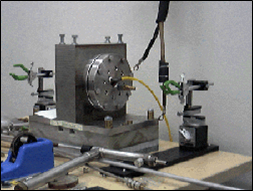 A long-pulse magnet with optimised layer brought the first world record for pulsed magnet by generating 73.4T non-destructively in a 10 mm bore. The small pulsed magnet coil, made of a Cu-Ag alloy wire with interlayer reinforcement of glass fibre, generated 73.4T with the pulse duration of 5ms.
A long-pulse magnet with optimised layer brought the first world record for pulsed magnet by generating 73.4T non-destructively in a 10 mm bore. The small pulsed magnet coil, made of a Cu-Ag alloy wire with interlayer reinforcement of glass fibre, generated 73.4T with the pulse duration of 5ms.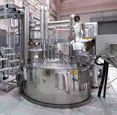 TML has also developed pulsed magnets and resistive magnets. A field of 37.9 T was generated with 33.25 kA operating current at 431V. The 32mm room-temperature bore insert magnet is divided into 3 coaxial coils: the bitter plates of the two inner coils are made of hard-worked Cu-Ag plates, and those of the outermost coil are made of GlidCop AL-25. the thickness of the plates used in the two inner coils was 0.84mm, and the 0.2% proof stress in the direction parallel to the roll work was about 800MPa at 375K. This temperature is designed to be the maximum of the innermost coil at 37.3T. In addition to that, the water flow in the insert magnet was highly regarded in the design for the better cooling.
TML has also developed pulsed magnets and resistive magnets. A field of 37.9 T was generated with 33.25 kA operating current at 431V. The 32mm room-temperature bore insert magnet is divided into 3 coaxial coils: the bitter plates of the two inner coils are made of hard-worked Cu-Ag plates, and those of the outermost coil are made of GlidCop AL-25. the thickness of the plates used in the two inner coils was 0.84mm, and the 0.2% proof stress in the direction parallel to the roll work was about 800MPa at 375K. This temperature is designed to be the maximum of the innermost coil at 37.3T. In addition to that, the water flow in the insert magnet was highly regarded in the design for the better cooling.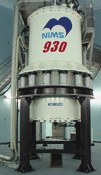 As the three dimensional structure of protein molecule was determined by the 920 MHz NMR in an effective manner, stronger magnetic field is able to provide NMR spectroscopy the better sensitivity, resolution and the chemical-shift dispersion.
As the three dimensional structure of protein molecule was determined by the 920 MHz NMR in an effective manner, stronger magnetic field is able to provide NMR spectroscopy the better sensitivity, resolution and the chemical-shift dispersion.